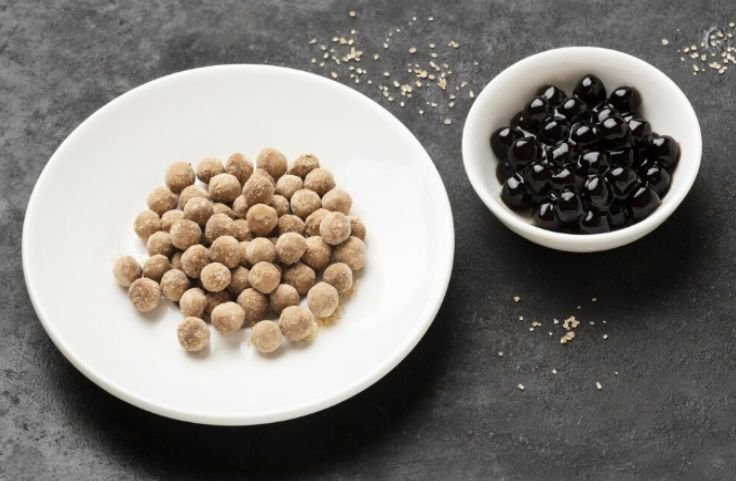Tapioca pearls add chewy charm to desserts and drinks. This ultimate guide covers what they are, their types, uses, and key facts, serving as your starting point for everything related to tapioca pearls.
Chances are, you have had boba pearls in your favorite bubble tea or seen them topping creamy desserts.
Tapioca pearls have a way of standing out, not just for their chewy bite but for how they tie into global food trends and traditions.
From street vendors to gourmet kitchens, these little spheres show up in surprising places.
If you’re curious about how they fit into different recipes, where they come from, or why they’re gluten-free and plant-based, you’re in the right place.
This guide pulls everything together, types, uses, facts, and more, so you can understand what makes tapioca pearls so popular worldwide.
When you’re ready to go deeper, each section links you to focused articles packed with practical details you can use.
If you are new to the tapioca discussion, this tapioca guide is necessary.
Table of Contents
- What Are Tapioca Pearls aka Boba Pearls?
- Origin of Tapioca Pearls
- What Are Boba Pearls Made From?
- Tapioca Pearls in Culinary Culture: How These Little Gems Travel Across Tables and Traditions
- Types of Tapioca Pearls
- How to Cook Boba Pearls
- Popular Recipes with Tapioca Boba Pearls: Taste, Texture, and Easy Ideas You Can Try Anytime
- Tapioca Pearls vs Other Starches and Ingredients
- Nutritional Profile of Tapioca Pearls
- Storage and Shelf Life: Keep Your Tapioca Pearls Fresh and Ready to Use
- Conclusion
- Frequently Asked Questions
What Are Tapioca Pearls aka Boba Pearls?
Tapioca pearls, also called boba pearls, are small, round balls made from tapioca flour, extracted from the cassava root. Naturally white and neutral in flavor, they become translucent and slightly chewy when cooked.
Boba pearls come in different sizes, ranging from mini to large, and can be used in a variety of sweet and savory dishes.
They’re most commonly known for their use in bubble tea, puddings, and dessert soups.
While some pearls are sold in their natural state, others may be pre-flavored or colored to enhance visual appeal and taste.
Origin of Tapioca Pearls
Tapioca pearls in beverages can be traced back to Taiwan in the 1980s, especially in bubble tea.
A tea stand owner named Lin Hsiu Hui is credited with first adding boba pearls to her tea drinks, creating the iconic bubble tea we know today.
The trend quickly caught on and spread to other countries in Asia and eventually to the United States and beyond.
In recent years, tapioca balls have also been incorporated into various desserts and snacks, further showcasing their versatility and popularity.
From milk teas to smoothies to ice cream, tapioca pearls have become a staple ingredient in many delicious treats.
They may be small in size, but they have certainly made a big impact on the culinary world.
In recent years, boba pearls have gained immense popularity on a global scale, largely driven by the booming trend of bubble tea.
The growing appeal of this unique beverage has sparked a significant increase in the demand for homemade boba pearls, as enthusiasts seek to recreate their favorite bubble tea experience at home.
What Are Boba Pearls Made From?
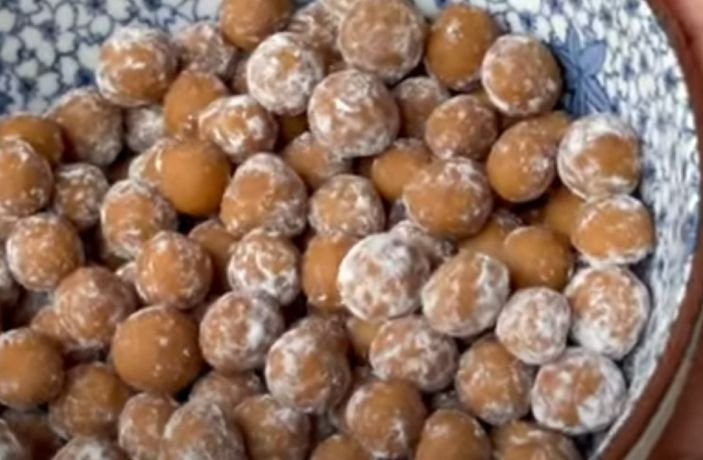
Boba pearls are made from the starch extracted from cassava root, a hardy plant that grows well in tropical regions.
After harvesting, the cassava is peeled, grated, and washed. The starch is then separated, dried, and used as the base for tapioca pearls.
This starch gives the pearls their signature chewiness and smooth texture.
In some cases, modified tapioca starch is used to improve how the pearls hold up in drinks or cooking.
These chewy balls are popular in bubble tea, desserts, and many Asian recipes.
Since they come from cassava, they reflect the plant’s role in global food security and cooking traditions.
Want to try making your own? Here’s a full guide on how to make tapioca boba pearls to get you started.
Related Posts
The Making of Tapioca Pancakes
The Best Tapioca Pearls for Pudding
Are Tapioca Balls the Same as Tapioca Pearls?
How to Make Boba Pearls Without Tapioca Starch
Tapioca Pearls in Culinary Culture: How These Little Gems Travel Across Tables and Traditions
You may know tapioca pearls as the chewy centers of bubble tea, but their story stretches far beyond that drink in your hand.
These pearls move through kitchens and cultures with ease, showing up in drinks, soups, stews, and even pancakes.
Let’s take a closer look at how different parts of the world use boba pearls to bring flavor and texture to their food.
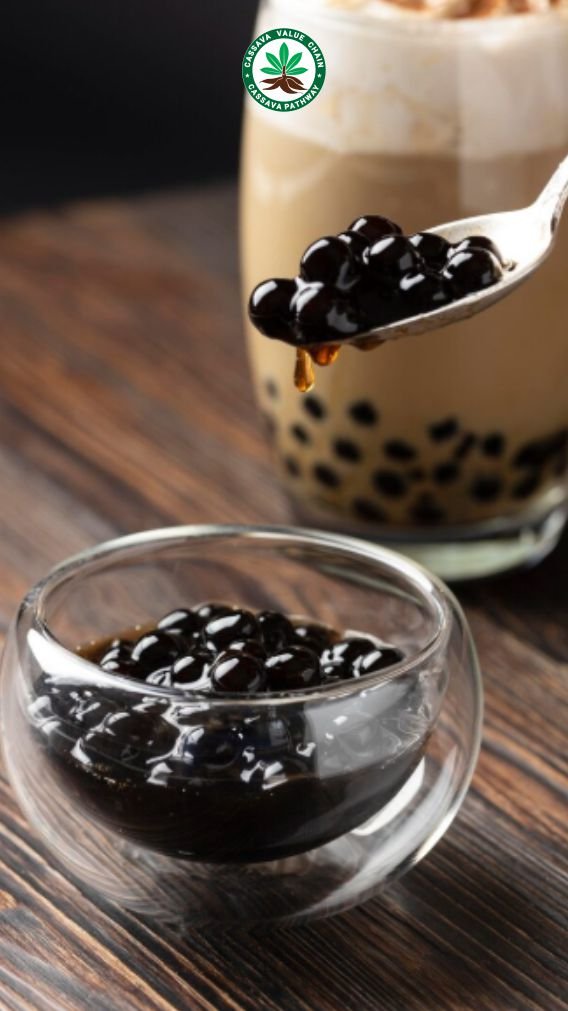
Asia: From Bubble Tea to Coconut Pudding, You’ll Find Tapioca Pearls Doing More Than You Think
In Asia, especially in Taiwan, tapioca pearls star in bubble tea. But that’s not their only role.
You’ll also find them in Thai coconut desserts where they soak up creamy goodness, paired with mango or pandan.
In Vietnam, they turn up in yam-based soups, adding a soft bite and light sweetness.
Here, pearls become more than an add-on. They become part of how texture and flavor balance out in each bite.
Africa: Traditional Recipes Still Make Room for Tapioca Pearls in Everyday Meals
In West African kitchens, boba pearls often show up in dishes like cassava fufu.
They aren’t just tucked away in snacks or drinks. They’re kneaded, stirred, and served alongside rich soups and meat-based sauces.
When you eat them this way, you see how much tapioca has settled into daily meals.
It’s not just about taste. It’s about nourishment, culture, and making use of what the land gives.
South America: A Pancake, a Tradition, and a Fresh Take on Tapioca
In Brazil, boba pearls get reimagined. Hydrated tapioca starch turns into a chewy flatbread called tapioca, filled with sweet or savory ingredients.
It’s common on street corners and in home kitchens, shaped by local customs but open to creativity.
You can go with cheese and coconut or chocolate and banana.
Each bite brings old and new flavors together in a way that feels both grounded and fresh.
Global Influence: Tapioca Pearls Keep Evolving With Every Culture They Touch
No matter where you find them, tapioca pearls carry stories. Some come in desserts.
Others arrive in soups or breads. But they all do one thing: invite people to taste something familiar in a new way.
From Asia to Africa to South America, these pearls are not just ingredients.
They’re pieces of tradition, shaped by hands, recipes, and memories across the world.
Types of Tapioca Pearls
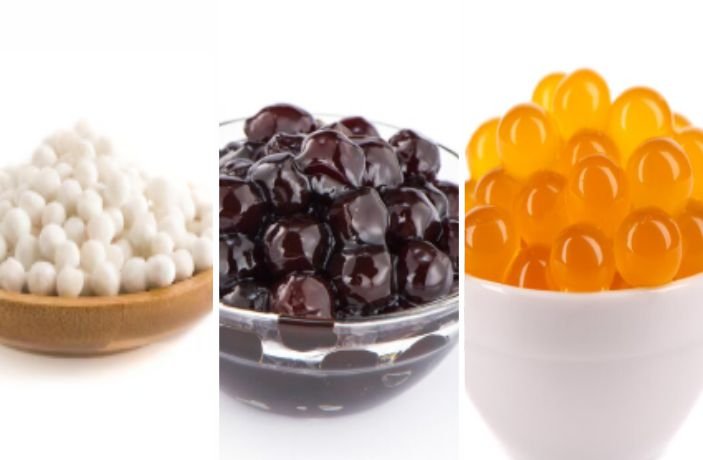
Tapioca boba pearls come in a variety of types, each with a specific texture, size, and use in the kitchen.
Small boba pearls, around 1 to 2 millimeters wide, are popular in puddings because they cook quickly and absorb flavors well.
Large pearls, usually 8 to 10 millimeters, are best known for their chewy bite in bubble tea.
Then there’s the choice between traditional and instant pearls. Traditional ones take longer to cook but offer a fuller, more authentic texture.
Instant pearls, on the other hand, are ready in minutes, making them convenient for busy days, though some find the texture slightly less satisfying.
There’s also a world beyond plain white pearls. Colored and flavored varieties like matcha, fruit, or brown sugar pearls add both visual appeal and extra taste.
Choosing the right type depends on your dish, your prep time, and the experience you want to create.
Dive deeper into our Types of Tapioca Pearls guide.
How to Cook Boba Pearls
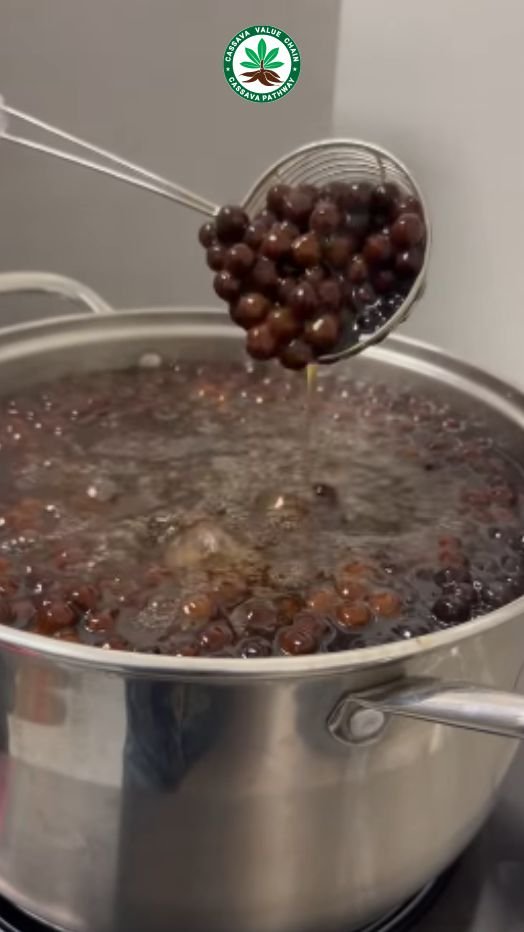
Cooking boba pearls isn’t complicated, but getting the texture right depends on understanding the type you’re using.
Small pearls cook faster, while large pearls, commonly used in bubble tea, require more time.
Soaking the pearls beforehand, usually for 30 minutes to an hour, helps soften them and shortens the cooking time.
After soaking, boil them in plenty of water using a 1:7 ratio of pearls to water. Stir gently as they cook to prevent clumping.
Depending on their size, cooking can take anywhere from 15 to 45 minutes. Keep checking for doneness; the pearls should look translucent and feel pleasantly chewy.
Once cooked, rinse them under cold water to stop the cooking and wash away excess starch.
You can also soak the finished pearls in syrup or flavored liquid to boost their taste.
Want step-by-step instructions for different pearl sizes? Visit our complete guide on How to Cook Tapioca Pearls.
Popular Recipes with Tapioca Boba Pearls: Taste, Texture, and Easy Ideas You Can Try Anytime
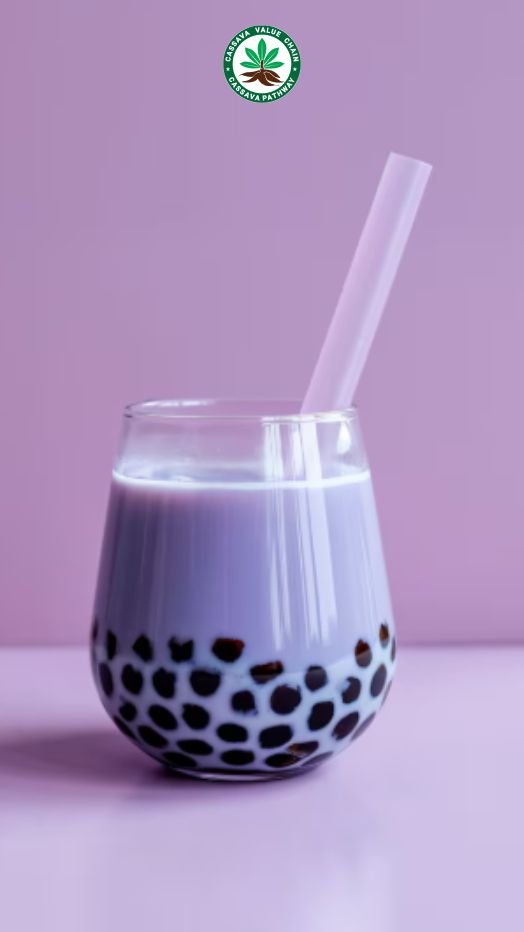
You don’t need fancy tools or rare ingredients to enjoy cooking with tapioca pearls.
Just a little time and curiosity, and you’ll have chewy, satisfying dishes that work for both snacks and desserts.
From drinks to pudding to gluten-free meals, here’s how you can enjoy these little pearls at home.
Bubble Tea
If you’ve ever had bubble tea, you already know how boba pearls add texture to your drink.
All you need is strong tea, your choice of milk or fruit syrup, and sweetened pearls.
Try flavors like matcha, taro, or mango. Serve it cold with a wide straw and let the pearls give each sip a chewy finish.
It’s easy to make and even better when you get the sweetness just right for your taste.
Tapioca Pudding
Pudding made with tapioca is one of the simplest ways to enjoy these pearls. Simmer them in milk with sugar until the mixture thickens and the pearls turn translucent.
You can stick with regular milk or try coconut milk or almond milk for a dairy-free twist.
Add a splash of vanilla or a sprinkle of nutmeg for extra flavor. It’s cozy, comforting, and surprisingly easy to make from scratch.
Tapioca Crepes
Tapioca crepes are made from hydrated tapioca starch and cook quickly on a hot pan.
The result is a chewy, flexible wrap that works with any filling. Go sweet with banana and chocolate, or savory with cheese and herbs.
You won’t need wheat flour or eggs, making this a great option if you’re going gluten-free or just want something different for breakfast or dinner.
Tapioca Cheese Balls
These bite-sized snacks combine tapioca flour with shredded cheese and a touch of water to form a dough. Roll into small balls and bake or fry until golden.
They’re crispy on the outside and stretchy in the middle. Perfect as a party snack or a quick afternoon treat.
Try adding garlic powder or herbs to mix up the flavor. More on tapioca cheese balls here.
Tapioca Pancakes and Waffles
You can fold cooked boba pearls into tapioca pancake or waffle batter for an extra chewy bite.
The pearls give your breakfast a texture that’s different from the usual fluffy style.
Top with fruit, syrup, or nut butter, and enjoy a twist on your morning routine. It’s a simple way to use leftover pearls from bubble tea or pudding recipes.
Want full recipes and step-by-step tips? Visit our Tapioca Pearls Recipes Guide.
Coconut Milk Tapioca
You choose this dessert when you crave something creamy with a tropical touch.
Coconut milk blends beautifully with the cooked pearls, creating a velvety base that feels light yet satisfying.
A little lime zest or toasted coconut works well when you want extra aroma and brightness.
This dish chills nicely, so it’s perfect on warm days or whenever you need a refreshing treat.
It’s also great if you prefer dairy-free options without losing that rich, smooth texture.
Chai-Spiced Tapioca
You make this recipe when you want warmth with a mild kick of spice.
Cardamom, cinnamon, cloves, and ginger turn a simple dessert into something cozy and inviting.
As the mixture thickens, it becomes silky and fragrant, giving you a relaxing treat after a long day.
Use whichever milk you prefer and adjust the sweetness to match your taste.
It’s ideal when you crave something comforting, aromatic, and slightly spicy without feeling heavy or overwhelming.
Chocolate Tapioca Parfait
You turn to this layered dessert when you want something indulgent but not too dense.
The pearls add a soft chew that pairs beautifully with rich chocolate.
Layer it with cream, fruit, or crushed cookies for extra depth and texture.
It chills well, so you can prepare it ahead when you want a ready-made treat waiting in the refrigerator.
It’s perfect for moments when you want chocolate with personality and a bit of playful texture.
Tapioca Pearls in Soup
You add pearls to soup when you want a mild thickening effect and a soft texture.
They absorb flavor nicely and turn a simple broth into something heartier and more satisfying.
This approach works well in clear vegetable soups or gentle chicken broths.
It’s a good option when you want something warm, light, and nurturing, especially on slow or rainy days.
The result is a bowl that feels familiar yet slightly different from your usual soup routine.
Tapioca Pearl Stir-Fry
You use cooked pearls in stir-fry when you want a fun twist on your usual meal.
After cooling the pearls, you toss them with vegetables, aromatics, and your favorite sauce.
They soak up flavor quickly and bring a soft contrast to crisp veggies.
This dish is convenient when you need something fast, filling, and gluten-free.
It gives you a balanced, tasty meal without requiring complicated steps, and it lets you play with textures you don’t get in classic stir-fries.
Mango Sticky Rice with Tapioca
You make this variation when you want a lighter version of the traditional Thai dessert.
Mixing in cooked pearls gives the dish a softer, more playful texture while still keeping the creamy richness of coconut milk.
Pair it with fresh mango slices for brightness and natural sweetness. It’s refreshing when chilled and comforting when served slightly warm.
This twist gives you a familiar flavor with a smoother finish, perfect when you want something tropical and satisfying.
Sweet Potato Balls with Tapioca
You prepare these when you want a snack that’s crisp outside and soft inside.
Mixing mashed sweet potatoes with starch creates a dough that fries beautifully, giving you golden bites with natural sweetness.
These balls are simple to make and perfect for snacking, especially when you want something warm and comforting.
Enjoy them plain or with a light drizzle of syrup. They hold their shape well and stay enjoyable even as they cool.
Fruit Tapioca Smoothies
You make these smoothies when you want a drink that feels more filling than a normal blend.
Adding a tapioca pearl component gives your smoothie a mild chewiness that pairs well with fruits like mango, pineapple, or banana.
It’s refreshing and hydrating, making it great for breakfast or a mid-day lift.
You can control the sweetness based on your fruit choices, keeping it nutritious and satisfying without needing heavy sweeteners.
Fizzy Tapioca Cocktails
You enjoy these drinks when you want something lively and fun for casual gatherings.
The base usually includes sparkling water or soda mixed with fruit syrups or light spirits.
The chewy tapioca pearls settle at the bottom and adds an unexpected twist as you sip.
You can adjust the sweetness and strength however you like, making it a flexible drink for different moods.
It’s refreshing, playful, and easy to prepare without needing complicated bar tools.
Herbal Tea with Pearls
You prepare this drink when you want a calm, warm experience with a bit of texture.
The tea gives you a soothing base, whether you prefer chamomile, mint, or hibiscus.
A lightly sweetened version works well if you want more depth, while an unsweetened one keeps it clean and gentle.
It’s perfect for quiet evenings or moments when you need something warm but not heavy.
This simple twist turns your regular herbal tea into something slightly more interesting.
Tapioca Pearl Ice Pops
You enjoy these ice pops when you want something cold, refreshing, and slightly chewy.
The pearls freeze inside the fruit or coconut milk mixture, giving each bite a fun, unexpected texture.
You can use any fruit blend you like, from berries to tropical flavors, depending on what you’re craving.
They’re easy to customize and ideal for hot days when you want a treat that feels light but still satisfying.
They also freeze well, making them convenient to keep on hand.
Tapioca Pearls vs Other Starches and Ingredients
When you’re working with chewy pearls or starchy bases, it helps to know exactly what’s in your bowl.
Boba pearls may look like other starch-based ingredients, but each one behaves differently in the kitchen.
Here’s how they compare and what that means for your recipes.
Sago Pearls
At first glance, sago pearls seem just like boba pearls. But they’re made from the starch of the sago palm, not cassava.
When cooked, sago pearls are usually more translucent and softer in texture.
They work well in warm puddings and soups where you want a gentler mouthfeel.
If you’ve used tapioca before and want a subtle shift in texture or flavor, sago might give your dessert the difference you didn’t know you were looking for.
Boba: A Bigger, Bolder Version Made for Drinks
Boba is a type of tapioca pearl, just larger and usually sweetened. You’ll find it in bubble tea, and that chewy texture is what makes the drink stand out.
Classic boba is dark and soaked in brown sugar syrup, while fruit-flavored boba adds a pop of taste and color.
While boba and tapioca pearls come from the same starch, boba is designed for sipping, not spooning.
Cassava Flour Pearls: A Baking Choice, Not a Dessert Swap
Cassava flour pearls may come from the same root as tapioca, but they behave differently.
The flour goes through a separate drying and grinding process that gives the pearls a firmer, more dough-like texture when cooked.
These pearls are better in baked goods or savory snacks than in soft puddings or drinks.
If you’re baking or air-frying, they’ll hold up. But if you want creaminess, stick with regular tapioca.
Nutritional Profile of Tapioca Pearls
Tapioca pearls, commonly used in bubble tea and desserts, are made from cassava starch and mainly provide carbohydrates.
A 28-gram serving contains about 100 calories, mostly from starch, offering a quick energy boost but little in terms of protein, fat, or fiber.
Their high glycemic index may not suit those managing blood sugar, but they are naturally gluten-free and free from common allergens like dairy, nuts, and soy.
This makes them a safe option for many with dietary restrictions.
While tapioca pearls add texture and taste to various recipes, they offer minimal vitamins or minerals.
So, it’s best to enjoy them occasionally and pair them with more nutrient-rich ingredients. See a dedicated post on the nutritional profile of tapioca pearls.
Storage and Shelf Life: Keep Your Tapioca Pearls Fresh and Ready to Use
If you’ve stocked up on tapioca pearls or have leftovers from bubble tea or pudding, knowing how to store them can help you get the best texture and taste every time.
Dry Tapioca Pearls: Keep Them Cool, Dry, and Sealed
Store your uncooked tapioca pearls in a cool, dry place away from sunlight and moisture.
Use an airtight container to keep out humidity that can cause clumping or spoilage.
If stored correctly, dry pearls can last up to one or even two years.
Still, it’s smart to check for mold, odor, or color changes before using them. This way, you know they’re safe and will cook up just right.
Cooked Tapioca Pearls: Use Quickly for the Best Texture
Once cooked, tapioca pearls don’t last long. Store them in an airtight container in the fridge and use them within three to five days.
Keep in mind that the pearls may lose some of their chewiness over time.
If they start to feel too firm or dry, try warming them in a little water to bring back some of their softness.
Freezing Cooked Pearls: Save Time But Expect a Texture Change
You can freeze cooked tapioca pearls, but their texture might change slightly.
To prevent sticking, spread them out on a baking sheet first, then move them to a freezer-safe bag or container.
They can stay frozen for one to two months.
When you’re ready to use them, let them thaw in the fridge and reheat with a splash of water to loosen them up again.
Want more tips on working with tapioca pearls? Visit our full guide on Tapioca Recipes and Storage Tips
Conclusion
Tapioca pearls offer more than just texture; they connect cultures, cuisines, and everyday meals in surprising ways.
Whether you’re enjoying a bubble tea on a hot afternoon, stirring pearls into a creamy pudding, or flipping tapioca crepes in your kitchen, these chewy spheres bring something fun and familiar to the table.
Their simple ingredients and adaptability have made them popular across continents and cooking styles.
From small pearls for quick puddings to larger ones for drinks, and from sweet to savory uses, there’s a tapioca pearl for nearly every dish.
Now that you’ve seen their many forms, uses, and origins, you’re better equipped to choose the right pearls and maybe even cook them yourself. Ready to try?
Frequently Asked Questions
Do tapioca pearls expire?
Yes, tapioca pearls do expire. Uncooked ones last months in a cool, dry place, while cooked pearls spoil quickly and should be used within hours.
Are tapioca pearls vegan?
Tapioca pearls are vegan-friendly. They’re made from cassava starch and water, with no animal products, though flavored or colored versions may include non-vegan additives.
Can you microwave tapioca pearls?
You can microwave tapioca pearls to reheat them. Add water, cover loosely, and heat in short intervals to avoid drying out or hardening the texture.
Do they contain sugar?
Plain tapioca pearls don’t contain sugar. However, flavored or boba-style pearls often have added sweeteners, especially those used in bubble tea drinks.

Chimeremeze Emeh is a writer and researcher passionate about Africa’s most transformative root crop—cassava. Through his work at cassavavaluechain.com, he explores the entire cassava industry, from cultivation and processing to its diverse applications in food, health, and industrial use.
He also writes for palmoilpalm.com, where he shares his extensive experience and deep-rooted knowledge of palm oil, covering red palm oil, palm kernel oil, and refined products. His work there reflects his lifelong connection to agriculture and his commitment to promoting sustainable value chains in Africa.
Driven by curiosity and purpose, Chimeremeze aims to shed light on how cassava continues to empower communities, strengthen food systems, and link traditional farming wisdom with modern innovation.

